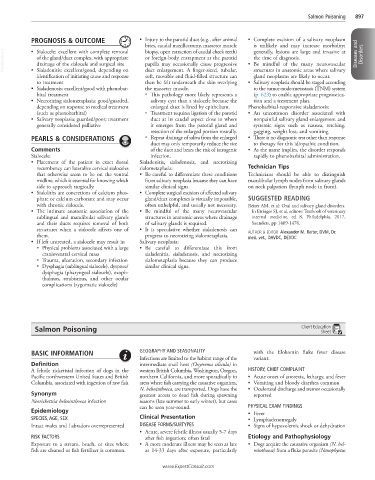Page 1790 - Cote clinical veterinary advisor dogs and cats 4th
P. 1790
Salmon Poisoning 897
PROGNOSIS & OUTCOME • Injury to the parotid duct (e.g., after animal • Complete excision of a salivary neoplasm
bites, caudal maxillectomy, masseter muscle is unlikely and may increase morbidity;
VetBooks.ir of the gland/duct complex, with appropriate or foreign-body entrapment at the parotid • Be mindful of the many neurovascular Diseases and Disorders
generally, lesions are large and invasive at
biopsy, open extraction of caudal cheek teeth)
• Sialocele: excellent with complete removal
the time of diagnosis.
papilla may occasionally cause progressive
drainage of the sialocele and surgical site
• Sialadenitis: excellent/good, depending on
gland neoplasms are likely to occur.
identification of initiating cause and response duct enlargement. A finger-sized, tubular, structures in anatomic areas where salivary
soft, movable and fluid-filled structure can
to treatment then be felt underneath the skin overlying • Salivary neoplasia should be staged according
• Sialadenosis: excellent/good with phenobar- the masseter muscle. to the tumor-node-metastasis (TNM) system
bital treatment ○ This pathology more likely represents a (p. 623) to enable appropriate prognostica-
• Necrotizing sialometaplasia: good/guarded, salivary cyst than a sialocele because the tion and a treatment plan.
depending on response to medical treatment enlarged duct is lined by epithelium. Phenobarbital-responsive sialadenosis:
(such as phenobarbital) ○ Treatment requires ligation of the parotid • An uncommon disorder associated with
• Salivary neoplasia: guarded/poor; treatment duct at its caudal aspect close to where nonpainful salivary gland enlargement and
generally considered palliative it emerges from the parotid gland and systemic signs such as nausea, retching,
resection of the enlarged portion rostrally. gagging, weight loss, and vomiting
PEARLS & CONSIDERATIONS ○ Repeat drainage of saliva from the enlarged • There is no diagnostic test other than response
duct may only temporarily reduce the size to therapy for this idiopathic condition.
Comments of the duct and bears the risk of iatrogenic • As the name implies, the disorder responds
Sialocele: infection. rapidly to phenobarbital administration.
• Placement of the patient in exact dorsal Sialadenitis, sialadenosis, and necrotizing
recumbency can lateralize cervical sialoceles sialometaplasia: Technician Tips
that otherwise seem to be on the ventral • Be careful to differentiate these conditions Technicians should be able to distinguish
midline, which is essential for knowing which from salivary neoplasia because they can have mandibular lymph nodes from salivary glands
side to approach surgically. similar clinical signs. on neck palpation (lymph node in front).
• Sialoliths are concretions of calcium phos- • Complete surgical excision of affected salivary
phate or calcium carbonate and may occur gland/duct complexes is virtually impossible, SUGGESTED READING
with chronic sialocele. often unhelpful, and usually not necessary. Reiter AM, et al: Oral and salivary gland disorders.
• The intimate anatomic association of the • Be mindful of the many neurovascular In Ettinger SJ, et al, editors: Textbook of veterinary
sublingual and mandibular salivary glands structures in anatomic areas where drainage internal medicine, ed 8, Philadelphia, 2017,
and their ducts requires removal of both of salivary glands is required. Saunders, pp 1469-1476.
structures when a sialocele affects one of • It is speculative whether sialadenosis can AUTHOR & EDITOR: Alexander M. Reiter, DVM, Dr.
them. progress to necrotizing sialometaplasia. med. vet., DAVDC, DEVDC
• If left untreated, a sialocele may result in Salivary neoplasia:
○ Physical problems associated with a large • Be careful to differentiate this from
cranioventral cervical mass sialadenitis, sialadenosis, and necrotizing
○ Trauma, ulceration, secondary infection sialometaplasia because they can produce
○ Dysphagia (sublingual sialocele), dyspnea/ similar clinical signs.
dysphagia (pharyngeal sialocele), exoph-
thalmos, strabismus, and other ocular
complications (zygomatic sialocele)
Salmon Poisoning Client Education
Sheet
BASIC INFORMATION GEOGRAPHY AND SEASONALITY with the Elokomin fluke fever disease
Infections are limited to the habitat range of the variant.
Definition intermediate snail host (Oxytrema silicula) in
A febrile rickettsial infection of dogs in the western British Columbia, Washington, Oregon, HISTORY, CHIEF COMPLAINT
Pacific northwestern United States and British northern California, and more sporadically in • Acute onset of anorexia, lethargy, and fever
Columbia, associated with ingestion of raw fish areas where fish carrying the causative organism, • Vomiting and bloody diarrhea common
N. helminthoeca, are transported. Dogs have the • Oculonasal discharge and tremor occasionally
Synonym greatest access to dead fish during spawning reported
Neorickettsia helminthoeca infection seasons (late summer to early winter), but cases
can be seen year-round. PHYSICAL EXAM FINDINGS
Epidemiology • Fever
SPECIES, AGE, SEX Clinical Presentation • Lymphadenomegaly
Intact males and Labradors overrepresented DISEASE FORMS/SUBTYPES • Signs of hypovolemic shock or dehydration
• Acute, severe febrile illness usually 5-7 days
RISK FACTORS after fish ingestion; often fatal Etiology and Pathophysiology
Exposure to a stream, beach, or sites where • A more moderate illness may be seen as late • Dogs acquire the causative organism (N. hel-
fish are cleaned or fish fertilizer is common. as 14-33 days after exposure, particularly minthoeca) from a fluke parasite (Nanophyetus
www.ExpertConsult.com

